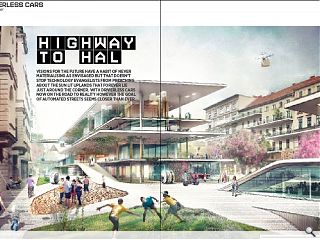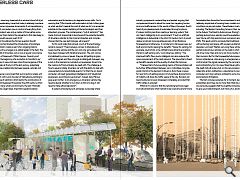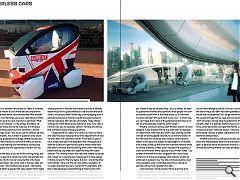Diverless Cars: Highway to Hal
15 Apr 2015
Visions for the future have a habit of never materialising as envisaged but that doesn’t stop technology evangelists from preaching about the sun lit uplands that forever lie just around the corner. With driverless cars now on the road to reality however the goal of automated streets seems closer than ever.
Technoheads have long dreamed of an elusive future full of jet packs and interplanetary travel but today’s relatively mundane world belies some impressive incremental, if not revolutionary, progress. With computers now in control of everything from airliners to missiles it was only a matter of time before some bright spark put them behind the wheel but is this idea likely to take off and would we even want it to?In an effort to address the former question the UK government has fast tracked the introduction of prototype vehicles on Britain’s roads as part of an ongoing trials to ensure the country emerges as a global leader in the field. The unnerving sight of driverless cars is now a regular occurrence on the streets of Greenwich, Milton Keynes, Coventry and Bristol. Is this the beginning of a revolution to transform our towns and cities in ways not seen since the emergence of the first automobiles at the turn of the last century, potentially ushering in a new relationship between people, vehicles and buildings.
Not everyone is convinced that such a techno-utopia will be benign with John Lord, founder of Yellowbook, pointing to the naive sense of optimism which led to the construction of motorways and bypasses throughout the 20th century which destroyed so many urban environments. He said: “Nicholas Carr’s The Glass Cage1 raises important questions about automation and its tendency to degrade human skills. Carr’s warning that ‘[t]he trouble with automation is that it often gives us what we don’t need at the cost of what we do’ is an essential antidote to the utopian babbling of the technologists and their attendant groupies. The contemporary “cult of optimism2” has made it almost impossible to look beyond the potential benefits of driverless vehicles to the moral ambiguities and complex choices that the new technologies will present.”
To this Lord notes that, at best, much of the technology remains nascent: “There’s always a driver in attendance to supervise the vehicle, and the cars can only go to places that have been mapped with fanatical precision. The cars can be immobilised by snow or leaves, they are still getting to grips with hand signals and they struggle to distinguish between, say, a rock in the road and a crumpled-up newspaper. Given time, the routine stuff can probably be dealt with. The challenge is how to equip a totally driverless car with the ability to deal with unexpected and unpredictable events. For that, the on-board computer will need ‘generalised intelligence’ and ‘situational awareness’, according to Lee Gomes2. Indeed, Gary Marcus goes even further: in an emergency, a driverless vehicle may need to decide whether to run down a child or a dog. It will need to make ethical decisions3.”
A system embodying such principles is precisely where industry proponents contend they are headed, arguing that computerised transit is about far more than negating human error and inefficiencies. In the words of Klaus Verweyen, Audi’s head of pre-development of automated driving functions, it’s about nothing less than creating a ‘learning system’ that can ‘react intelligently to its environment’. If such an artificial intelligence is deliverable in the short to medium term it would deliver an almost inconceivable panoply of ramifications, foreseeable and otherwise. In simple terms Verweyen sees our built environments reaping the benefits: “Space for parking, for example, could shrink or be shifted to less attractive locations thanks to self-parking cars,” Lord observes, adding: “The improved traffic flow due to intelligent cars also reduces the space requirement of the road network. The space that is freed up benefits people, and the quality of urban life improves.
“I believe that in future existing means of transportation will be further differentiated. Between cars, motorbikes, bicycles, public transit or the decision to travel on foot, there is space for new forms of getting around. In future these diverse forms of mobility will share the traffic space of the city. Borders can become blurred or even disappear completely, provided that traffic safety is ensured.”
What isn’t in doubt is that the remaining technical, legal and cultural barriers which remain to be overcome are far more formidable than those thus far encountered in achieving the relatively simple task of running basic models under controlled conditions on pre-set routes. Nevertheless most analysts, including The Boston Consulting Group in their report, Back to the Future: The Road to Autonomous Driving4, believe that partially autonomous vehicles could be available in the very near future with fully autonomous successors appearing around 2025. This leads Lord to conclude that traditional vehicles will be sharing road space with souped up alternatives for decades. Lord said: “Before very long there will be a class of partial-autonomous vehicles on the road in which computers will drive more miles and carry out more routine manoeuvres than humans. But for the foreseeable future people will need to be in attendance, intervening in emergencies and assuming control when the signals received by the car are too confusing and contradictory for it to cope. Road travel will be safer and the death toll will reduce but, on the rare occasions when we are called into action, inattention, a reluctance to countermand the computer and ring-rustiness will lead to some messy mistakes and a festival of litigation.
“But let’s indulge ourselves for a moment, because the possibilities (and they are no more than that) are sensational. No one seriously suggests that the wealthy and powerful are going to give up private transport, but many of us are likely to find the prospect of cars on demand very attractive. Fleets of driverless taxis could take millions of cars off the road and improve the utilisation of the total vehicle stock dramatically. Who wouldn’t like the idea of a car that takes you to your destination and then takes itself off to serve the next customer or park itself? Most of the time cars just sit there – in the garage, the station car park, in the multi-storey and by the road side. In a driverless world there will still be peak hours and downtime – and the associated storage issues – but we can use the vehicles we have much more efficiently. Any number of questions arise: about demand, pricing, geographical coverage, disabled access and the impact on mass transit and commercial traffic, as well as practical issues like cleaning and maintenance, but the prize is huge: nothing less than the opportunity to reclaim our city streets.
“It won’t be that easy, of course. We like owning things, and nobody wants to get into a robotic taxi full of crisp packets and smelling of socks. But for now let’s assume that in the future there will be many fewer cars on the road. It may be a safer bet that these vehicles – the driverless ones at least – will behave better. They will observe speed limits, obey signals (which might become redundant over time) and not drive under the influence of drink or drugs; they won’t fall asleep at the wheel, get bored or turn round to shout at the kids. An interesting question is what proportion of vehicles would need to be fully or partially autonomous for this good behaviour to set the standard for all drivers, including humans? Either way, once the tipping point is reached and decorous manners prevail, the opportunities for sharing road space with vehicles will multiply. Today, shared surfaces are a faith-based policy: before too long, if you walk in front of a car, you can be pretty certain it will stop, and having that confidence would change everything.
“I suppose that’s it, really. For a century or more our towns and cities have been designed around the requirements of road vehicles, often with calamitous results. For at least 30 years a lot of people have been worrying about the consequences of what we’ve done and planners and policy-makers have tried their best to roll-back the tide, tearing down urban motorways, pedestrianizing city streets and experimenting with shared surfaces. This civilising mission has had some notable successes and, indeed, car ownership and mileage seem to have peaked in Britain, at least for the time being. But cars – and all the other road vehicles – have won the war and, without exception, all our great cities bear the scars. The techno-triumphalists, with their under-developed understanding of history and human behaviour, think all this can be spirited away in a few years. It can’t, because we’re locked into the old infrastructure and the old ways of doing things, and because the technology isn’t here yet. Indeed, it may be decades away – and, as always, we need to question the motives and aspirations of the people who own and stand to profit from it. And what about us? Do we want driverless vehicles? Will we all want to own one – in which case you can forget about many of the potential benefits above? Or will we enthusiastically adopt the rental model?”
Whether owning or renting Geoff Whitten, director of urban design at Turley, stresses that the true distinction lies between so-called smart motorways and smart cities, pointing out that vehicles will evolve greater diversity to suit niche functions. At its most basic this would see long-distance carriers grow to feature more capacious designs for passengers to while away time as they shuttle up and down the motorway network whilst for shorter distances smaller ‘pods’ may become ubiquitous in urban environments where capacity is key. Whitten noted: “City dwellers will benefit from less congestion and visual clutter in the form of railings and signage whilst suburbs will also be enhanced as a place to live. The daily commute could be much more enjoyable using a controlled autonomous vehicle as journeys will be more consistent and safe.”
Lord concludes: “Some powerful forces are lining up to create the driverless future, and to profit from it: technology companies, auto-makers and others. As Mui and Carroll say, “trillions are up for grabs”. Predicting the future is a mug’s game, but the real challenge is political. How can a country in which the idea of the public realm has been systematically demeaned ensure that, to paraphrase Carr, we get the technology (and the societal change) that we need, and not necessarily what we want? Driverless vehicles have the potential to offer enormous benefits, albeit in a relatively distant future, but only if we return to the social-democratic principle that that the common good should prevail over individual desires5. Otherwise we will be at the tender mercies of global corporations and charismatic libertarian entrepreneurs.”
Whether autonomous vehicles prove less elusive than jet packs and interplanetary travel and are let loose into the wild years or decades hence the direction of travel is clear, driverless vehicles are coming whether our cities are ready or not.
1. Nicholas Carr, The Glass Cage: Where Automation is Taking Us, The Bodley Head, London, 2015
2. See, for example, Brian Appleyard, “The Happiness Conspiracy”, New Statesman, 19 February, 2015
3. See Lee Gomes, “Driving in Circles”, www.slate.com 21 October 2014, and the same author’s “Hidden Obstacles for Google’s Self-Driving Cars”, MIT Technology Review 28 August 2014
3. Gary Marcus, “Moral Machines”, New Yorker, 24 November 2014
4. For a summary see www.slideshare.net/TheBostonConsultingGroup/the-road-to-autonomous-driving
5. See David Marquand, Mammon’s Kingdom: An Essay on Britain, Now, Allen Lane, London, 2014
|
|
Read next: Tower Blocks
Read previous: Sauchiehall Street
Back to April 2015
Browse Features Archive
Search
News
For more news from the industry visit our News section.
Features & Reports
For more information from the industry visit our Features & Reports section.





